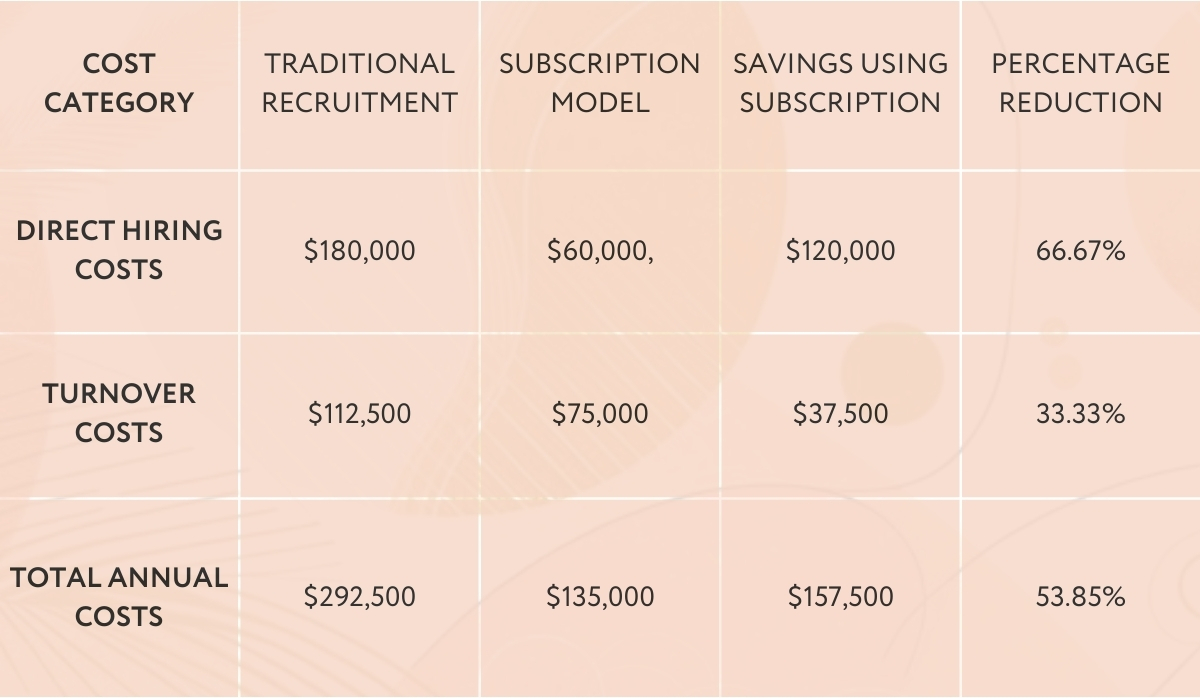In the cutthroat realm of technology recruitment, the traditional methodologies of attracting talent resemble an antiquated, costly gamble. Glassdoor reveals that hiring a single tech talent can cost anywhere from $4,000 to $20,000 depending on their experience level.
The old-school arsenal of job boards, headhunting sagas, and agency liaisons drains the coffers and ensnares valuable resources in a web of inefficiency. Enter the subscription model: a bold paradigm shift in recruitment, wielding the promise of economic rationality and strategic foresight.
This model champions a fixed monthly fee, defying the exorbitant expenses of its predecessors. Imagine a company, shackled by traditional hiring practices, now liberated with an average monthly subscription fee of $3000 - $5,000.
This fee unlocks a treasure trove of recruitment services, from job postings and full-cycle recruitment to applicant tracking setup and business content, heralding a new era of streamlined efficiency and focused resource allocation towards core business growth.
The economic allure of the subscription model is indisputable. By offering access to a broader talent pool, including the elusive passive candidates, companies are not merely hiring; they're strategically investing in quality talent poised to drive down turnover rates.
This approach doesn't just save pennies; it fundamentally transforms recruitment into a strategic asset, with flexibility at its core. Companies can dynamically adjust their recruitment throttle based on real-time needs, ensuring a lean, agile hiring process that aligns with business rhythms.
Diving into the numbers unveils the model's stark economic advantage. Traditional recruitment methods often result in a significant loss of funds, with costs spiraling annually, considering direct hiring and turnover costs. Contrast this with the subscription model's streamlined efficiency, which caps annual expenditure.
This isn't mere savings; it's a financial revolution, unlocking your saved money that can be reinvested into innovation, growth, and competitive differentiation.
The subscription model is not just an alternative; it's a categorical imperative for the tech sector, a strategic linchpin that redefines recruitment. By adopting this model, companies don't just hire; they strategically amplify their growth potential, turning the recruitment process from a financial burden into a competitive advantage.
This model champions a fixed monthly fee, defying the exorbitant expenses of its predecessors. Imagine a company, shackled by traditional hiring practices, now liberated with an average monthly subscription fee of $3000 - $5,000.
This fee unlocks a treasure trove of recruitment services, from job postings and full-cycle recruitment to applicant tracking setup and business content, heralding a new era of streamlined efficiency and focused resource allocation towards core business growth.
The economic allure of the subscription model is indisputable. By offering access to a broader talent pool, including the elusive passive candidates, companies are not merely hiring; they're strategically investing in quality talent poised to drive down turnover rates.
This approach doesn't just save pennies; it fundamentally transforms recruitment into a strategic asset, with flexibility at its core. Companies can dynamically adjust their recruitment throttle based on real-time needs, ensuring a lean, agile hiring process that aligns with business rhythms.
Diving into the numbers unveils the model's stark economic advantage. Traditional recruitment methods often result in a significant loss of funds, with costs spiraling annually, considering direct hiring and turnover costs. Contrast this with the subscription model's streamlined efficiency, which caps annual expenditure.
This isn't mere savings; it's a financial revolution, unlocking your saved money that can be reinvested into innovation, growth, and competitive differentiation.
The subscription model is not just an alternative; it's a categorical imperative for the tech sector, a strategic linchpin that redefines recruitment. By adopting this model, companies don't just hire; they strategically amplify their growth potential, turning the recruitment process from a financial burden into a competitive advantage.
To construct a detailed analysis demonstrating the cost-effectiveness and strategic benefits of the subscription-based recruitment model over traditional recruitment methods, let's develop a hypothetical scenario with associated calculations. This analysis will provide a clearer understanding of the potential financial impacts and strategic advantages.
Assumptions:
Traditional Recruitment Costs:
The cost per hire using traditional methods averages $15,000 for tech positions. This figure includes advertising, agency fees, and administrative costs associated with the hiring process.
Subscription Model Costs:
A company opts for a subscription-based recruitment service at a fixed monthly fee of $5,000. The subscription includes job postings, candidate screening, and applicant tracking services.
Annual Hiring Needs:
The company needs to fill 12 tech positions over a year.
Turnover Rate:
The industry average turnover rate is 15% per year.
Cost of Turnover:
As per SHRM, the cost of turnover is estimated at six to nine months of an employee's salary. For this scenario, we'll use an average annual salary of $100,000 for tech positions, making the cost of turnover $50,000 to $75,000 per position.
Traditional Recruitment Cost Analysis:
Direct Hiring Costs: $15,000 * 12 positions = $180,000
Turnover Costs: Assuming a 15% turnover rate, 1.8 positions would need to be refilled annually. Using the midpoint of turnover cost estimates, $62,500 * 1.8 = $112,500
Subscription Model Cost Analysis:
Subscription Costs: $5,000 monthly fee * 12 months = $60,000
Reduced Turnover Costs: Assuming the subscription model leads to better hires and reduces the turnover rate by 5% (to 10%), 1.2 positions need refilling. $62,500 * 1.2 = $75,000
Comparative Analysis:
Annual Cost with Traditional Recruitment: $292,500
Annual Cost with Subscription Model: $135,000
Traditional Recruitment Costs:
The cost per hire using traditional methods averages $15,000 for tech positions. This figure includes advertising, agency fees, and administrative costs associated with the hiring process.
Subscription Model Costs:
A company opts for a subscription-based recruitment service at a fixed monthly fee of $5,000. The subscription includes job postings, candidate screening, and applicant tracking services.
Annual Hiring Needs:
The company needs to fill 12 tech positions over a year.
Turnover Rate:
The industry average turnover rate is 15% per year.
Cost of Turnover:
As per SHRM, the cost of turnover is estimated at six to nine months of an employee's salary. For this scenario, we'll use an average annual salary of $100,000 for tech positions, making the cost of turnover $50,000 to $75,000 per position.
Traditional Recruitment Cost Analysis:
Direct Hiring Costs: $15,000 * 12 positions = $180,000
Turnover Costs: Assuming a 15% turnover rate, 1.8 positions would need to be refilled annually. Using the midpoint of turnover cost estimates, $62,500 * 1.8 = $112,500
Subscription Model Cost Analysis:
Subscription Costs: $5,000 monthly fee * 12 months = $60,000
Reduced Turnover Costs: Assuming the subscription model leads to better hires and reduces the turnover rate by 5% (to 10%), 1.2 positions need refilling. $62,500 * 1.2 = $75,000
Comparative Analysis:
Annual Cost with Traditional Recruitment: $292,500
Annual Cost with Subscription Model: $135,000

Explore why the subscription model not only promises a more streamlined, cost-effective approach to recruitment but also a more human-centric, relationship-driven experience.
https://minddn.com/tpost/tub90eg9c1-the-strategic-shift-embracing-a-subscrip

